- GCN/BACODINE POSITION NOTICE
TITLE: GCN/SWIFT NOTICE
NOTICE_DATE: Thu 05 Jan 06 06:49:44 UT
NOTICE_TYPE: Swift-BAT GRB Position
TRIGGER_NUM: 175942, Seg_Num: 0
GRB_RA: 297.474d {+19h 49m 54s} (J2000),
297.519d {+19h 50m 05s} (current),
297.092d {+19h 48m 22s} (1950)
GRB_DEC: +46.362d {+46d 21' 45"} (J2000),
+46.378d {+46d 22' 41"} (current),
+46.235d {+46d 14' 06"} (1950)
GRB_ERROR: 3.00 [arcmin radius, statistical only]
GRB_INTEN: 9703 [cnts] Image_Peak=450 [image_cnts]
TRIGGER_DUR: 1.024 [sec]
TRIGGER_INDEX: 155 E_range: 50-350 keV
BKG_INTEN: 33514 [cnts]
BKG_TIME: 24552.00 SOD {06:49:12.00} UT
BKG_DUR: 8 [sec]
GRB_DATE: 13740 TJD; 5 DOY; 06/01/05
GRB_TIME: 24568.38 SOD {06:49:28.38} UT
GRB_PHI: 20.80 [deg]
GRB_THETA: 42.93 [deg]
SOLN_STATUS: 0x3
RATE_SIGNIF: 77.70 [sigma]
IMAGE_SIGNIF: 14.40 [sigma]
MERIT_PARAMS: +1 +0 +0 +0 +3 +20 +0 +0 -34 +1
SUN_POSTN: 286.05d {+19h 04m 12s} -22.62d {-22d 37' 04"}
SUN_DIST: 69.77 [deg]
MOON_POSTN: 356.09d {+23h 44m 21s} -3.09d {-03d 05' 38"}
MOON_DIST: 71.33 [deg]
MOON_ILLUM: 33 [%]
GAL_COORDS: 80.23, 10.08 [deg] galactic lon,lat of the burst (or transient)
ECL_COORDS: 319.30, 65.17 [deg] ecliptic lon,lat of the burst (or transient)
COMMENTS: SWIFT-BAT GRB Coordinates.
COMMENTS: NOTE: Until the UTCF problem is solved, the UTCF correction to all times has been removed.
COMMENTS: NOTE: The UTCF is small, typically between -1.0 and +1.0 seconds.
COMMENTS: This is a rate trigger.
COMMENTS: A point_source was found.
COMMENTS: This does not match any source in the on-board catalog.
COMMENTS: This does not match any source in the ground catalog.
COMMENTS: This is a GRB.
COMMENTS: This trigger occurred at longitude,latitude = 86.41,20.52 [deg].
- red DSS finding chart
ps-file
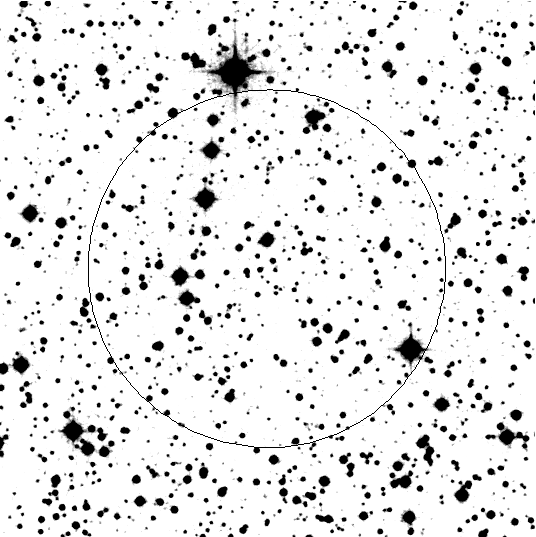
- GCN NOTICE
TITLE: GCN/SWIFT NOTICE
NOTICE_DATE: Thu 05 Jan 06 06:53:12 UT
NOTICE_TYPE: Swift-BAT GRB Lightcurve
TRIGGER_NUM: 175942, Seg_Num: 0
GRB_RA: 297.474d {+19h 49m 54s} (J2000),
297.519d {+19h 50m 05s} (current),
297.092d {+19h 48m 22s} (1950)
GRB_DEC: +46.362d {+46d 21' 45"} (J2000),
+46.378d {+46d 22' 41"} (current),
+46.235d {+46d 14' 06"} (1950)
GRB_DATE: 13740 TJD; 5 DOY; 06/01/05
GRB_TIME: 24568.38 SOD {06:49:28.38} UT
TRIGGER_INDEX: 155
GRB_PHI: 20.80 [deg]
GRB_THETA: 42.93 [deg]
DELTA_TIME: 65498.00 [sec]
TRIGGER_DUR: 1.024 [sec]
LC_URL: sw00175942000msb.lc
SUN_POSTN: 286.05d {+19h 04m 13s} -22.62d {-22d 37' 03"}
SUN_DIST: 69.77 [deg]
MOON_POSTN: 356.12d {+23h 44m 28s} -3.08d {-03d 04' 39"}
MOON_DIST: 71.33 [deg]
MOON_ILLUM: 33 [%]
GAL_COORDS: 80.23, 10.08 [deg] galactic lon,lat of the burst (or transient)
ECL_COORDS: 319.30, 65.17 [deg] ecliptic lon,lat of the burst (or transient)
COMMENTS: SWIFT-BAT GRB Lightcurve.
COMMENTS:
COMMENTS: The next comments were copied from the BAT_POS Notice:
COMMENTS: This is a rate trigger.
COMMENTS: A point_source was found.
COMMENTS: This does not match any source in the on-board catalog.
COMMENTS: This does not match any source in the ground catalog.
COMMENTS: This is a GRB.
COMMENTS: This trigger occurred at longitude,latitude = 86.41,20.52 [deg].
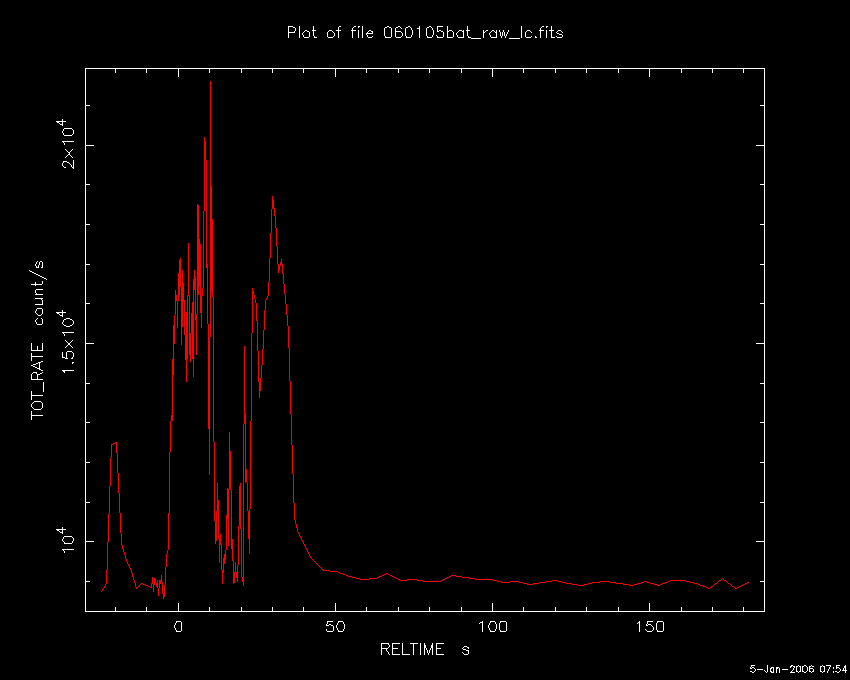
- GCN NOTICE
TITLE: GCN/SWIFT NOTICE
NOTICE_DATE: Thu 05 Jan 06 06:55:04 UT
NOTICE_TYPE: Swift-UVOT Source List
TRIGGER_NUM: 175942, Seg_Num: 0
POINT_RA: 297.474d {+19h 49m 54s} (J2000)
POINT_DEC: +46.365d {+46d 21' 56"} (J2000)
POINT_ROLL: 191.235d
IMG_START_DATE: 13740 TJD; 5 DOY; 06/01/05
IMG_START_TIME: 24658.40 SOD {06:50:58.40} UT, 90.0 [sec] since BAT Trigger Time
FILTER: 3, V
BKG_MEAN: 0.937
N_STARS: 190
X_OFFSET: 443 [pixels]
Y_OFFSET: 378 [pixels]
X_MAX: 1402 [pixels]
Y_MAX: 1337 [pixels]
DET_THRESH: 8
PHOTO_THRESH: 4
SL_URL: sw00175942000msufc0090.fits
SUN_POSTN: 286.05d {+19h 04m 13s} -22.62d {-22d 37' 02"}
SUN_DIST: 69.78 [deg]
MOON_POSTN: 356.13d {+23h 44m 32s} -3.07d {-03d 04' 07"}
MOON_DIST: 71.34 [deg]
MOON_ILLUM: 33 [%]
GAL_COORDS: 80.23, 10.08 [deg] galactic lon,lat of the pointing direction
ECL_COORDS: 319.30, 65.17 [deg] ecliptic lon,lat of the pointing direction
COMMENTS: SWIFT-UVOT Source List.
- GCN NOTICE
TITLE: GCN/SWIFT NOTICE
NOTICE_DATE: Thu 05 Jan 06 06:55:48 UT
NOTICE_TYPE: Swift-UVOT Processed Source List
TRIGGER_NUM: 175942, Seg_Num: 0
POINT_RA: 297.474d {+19h 49m 54s} (J2000)
POINT_DEC: +46.365d {+46d 21' 56"} (J2000)
POINT_ROLL: 191.235d
IMG_START_DATE: 13740 TJD; 5 DOY; 06/01/05
IMG_START_TIME: 24658.40 SOD {06:50:58.40} UT, 90.0 [sec] since BAT Trigger Time
FILTER: 3, V
BKG_MEAN: 0.937
N_STARS: 190
X_OFFSET: 443 [pixels]
Y_OFFSET: 378 [pixels]
X_MAX: 1402 [pixels]
Y_MAX: 1337 [pixels]
DET_THRESH: 8
PHOTO_THRESH: 4
SL_URL: sw00175942000msufc0090.fits
SUN_POSTN: 286.05d {+19h 04m 13s} -22.62d {-22d 37' 02"}
SUN_DIST: 69.78 [deg]
MOON_POSTN: 356.14d {+23h 44m 34s} -3.07d {-03d 03' 55"}
MOON_DIST: 71.34 [deg]
MOON_ILLUM: 33 [%]
GAL_COORDS: 80.23, 10.08 [deg] galactic lon,lat of the pointing direction
ECL_COORDS: 319.30, 65.17 [deg] ecliptic lon,lat of the pointing direction
COMMENTS: SWIFT-UVOT Processed Source List.
COMMENTS: All 4 attachments are included.
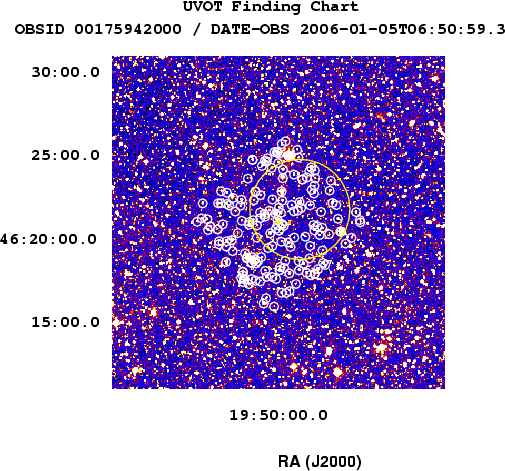
- GCN NOTICE
TITLE: GCN/SWIFT NOTICE
NOTICE_DATE: Thu 05 Jan 06 06:56:32 UT
NOTICE_TYPE: Swift-UVOT Image
TRIGGER_NUM: 175942, Seg_Num: 0
POINT_RA: 297.474d {+19h 49m 54s} (J2000)
POINT_DEC: +46.365d {+46d 21' 56"} (J2000)
ROLL: 191.235d
IMG_START_DATE: 13740 TJD; 5 DOY; 06/01/05
IMG_START_TIME: 24658.40 SOD {06:50:58.40} UT, 90.0 [sec] since BAT Trigger Time
FILTER: 3, V
EXPOSURE_ID: 158136659
X_OFFSET: 763 [pixels]
Y_OFFSET: 698 [pixels]
WIDTH: 160 [pixels]
HEIGHT: 160 [pixels]
X_GRB_POS: 923
Y_GRB_POS: 858
BINNING_INDEX: 1
IM_URL: sw00175942000msuni0090.fits
SUN_POSTN: 286.06d {+19h 04m 13s} -22.62d {-22d 37' 02"}
SUN_DIST: 69.78 [deg]
MOON_POSTN: 356.15d {+23h 44m 35s} -3.06d {-03d 03' 43"}
MOON_DIST: 71.34 [deg]
MOON_ILLUM: 33 [%]
GAL_COORDS: 80.23, 10.08 [deg] galactic lon,lat of the pointing direction
ECL_COORDS: 319.30, 65.17 [deg] ecliptic lon,lat of the pointing direction
COMMENTS: SWIFT-UVOT Image.
COMMENTS: The GRB Position came from the XRT Position Command.
COMMENTS: The image has 2x2 binning (compression).
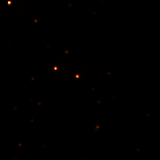
- GCN NOTICE
TITLE: GCN/SWIFT NOTICE
NOTICE_DATE: Thu 05 Jan 06 06:56:57 UT
NOTICE_TYPE: Swift-UVOT Processed Image
TRIGGER_NUM: 175942, Seg_Num: 0
POINT_RA: 297.474d {+19h 49m 54s} (J2000)
POINT_DEC: +46.365d {+46d 21' 56"} (J2000)
ROLL: 191.235d
IMG_START_DATE: 13740 TJD; 5 DOY; 06/01/05
IMG_START_TIME: 24658.40 SOD {06:50:58.40} UT, 90.0 [sec] since BAT Trigger Time
FILTER: 3, V
EXPOSURE_ID: 158136659
X_OFFSET: 763 [pixels]
Y_OFFSET: 698 [pixels]
WIDTH: 160 [pixels]
HEIGHT: 160 [pixels]
X_GRB_POS: 923
Y_GRB_POS: 858
BINNING_INDEX: 1
IM_URL: sw00175942000msuni0090.fits
SUN_POSTN: 286.06d {+19h 04m 13s} -22.62d {-22d 37' 02"}
SUN_DIST: 69.78 [deg]
MOON_POSTN: 356.15d {+23h 44m 36s} -3.06d {-03d 03' 36"}
MOON_DIST: 71.34 [deg]
MOON_ILLUM: 33 [%]
GAL_COORDS: 80.23, 10.08 [deg] galactic lon,lat of the pointing direction
ECL_COORDS: 319.30, 65.17 [deg] ecliptic lon,lat of the pointing direction
COMMENTS: SWIFT-UVOT Processed Image.
COMMENTS: All 4 attachments are included.
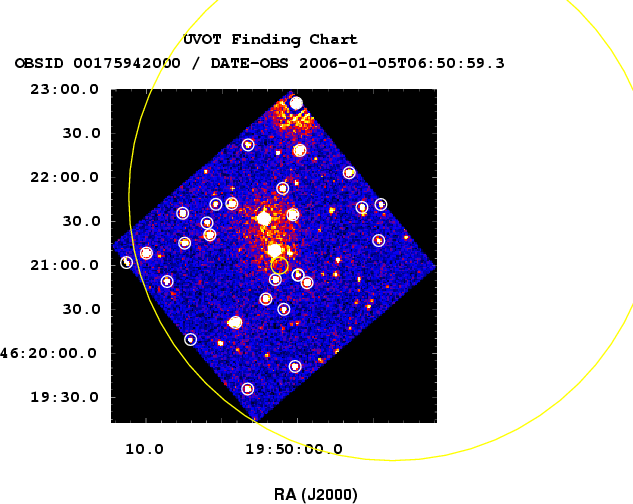
- GCN Circular #4429
H. Ziaeepour (UCL-MSSL), A. Blustin (UCL-MSSL), D. Burrows (PSU),
J. Cummings (GSFC/ORAU), N. Gehrels (GSFC), O. Godet (U. Leicester),
J. Kennea (PSU), C. Markwardt (GSFC/UMd), K. Page (U. Leicester), and
D. Palmer (LANL)
on behalf of the Swift team:
At 06:49:28 UT, Swift-BAT triggered and located GRB 060105
(trigger=175942). The spacecraft slewed immediately. The BAT
on-board calculated location is RA,Dec 297.474d, +46.362d
{19h 49m 54s, +46d 21' 45"} (J2000), with an uncertainty of
3 arcmin (radius, 90% containment, stat+sys). The BAT light curve
shows a multi-peaked structure with a total
duration of 60 sec, beginning around T-20s. The peak count
rate is ~20000 counts/sec (15-350 keV), at ~10 seconds after
the trigger.
XRT began observing the field at 06:50:55.3 UT, 87 sec after the BAT
trigger. Onboard centroiding found a bright fading uncatalogued X-ray
source in the field of view at the following coordinates:
RA(J2000): 19h 50m 01.1s
Dec(J2000): +46d 21' 01.0"
We estimate the uncertainty of this position to be 7 arcsec (radius,
90% containment). This uncertainty includes a systematic error of
about 5 arcseconds in the on-board calculated positions due to
the XRT boresight offset. This position is 87 arcsec from the BAT
position above. The initial source flux is 6.8e-9 erg/cm2/sec.
We note that the automated GCN notice identified this as a
probable cosmic ray. The XRT image at the position given above is
definitely a bright celestial source, not a cosmic ray.
UVOT took a finding chart exposure of 200 seconds with the V filter
starting 91 seconds after the BAT trigger. The 2.7'x2.7' sub-image
covers 100% of the XRT error circle. The 8'x8' region for the list
of sources generated on-board covers 100% of the XRT error circle.
No unambiguous afterglow candidate has been found in the initial
data products, although there is a potential low-significance UVOT
counterpart on the edge of the XRT error circle, at
RA=19h 50m 01s DEC=+46d 20m 56s, with a V magnitude of ~19.
The typical 3-sigma upper limit has been about 18th mag.
No correction has been made for the expected visual
extinction of about 0.6 magnitudes. The XRT position is very close
to a bright (B mag ~ 12.8) star.
We are currently in the portion of the orbits where the spacecraft
does not pass over the Malindi downlink station. Therefore, it will
be ~8 hours before we have access to the full data set for the
refined analyses.
- GCN Circular #4430
GRB060105 : Kiso optical observation
H. Izumiura (NAOJ), H. Mito(Tokyo U.), Y. Urata (RIKEN), K.Y. Huang,
W.H. Ip (NCU), Y. Qiu (BAO) on behalf of EAFON report:
" We started R band imaging observation for GRB 060105 (Ziaeepour et
al. # 4429) using Kiso observatory's 1.05-m Schmidt telescope at 09:39
UT (2.82 hour after the burst). There are no new sources down to the
R=20.2 (S/N=3). Since we could not find the UVOT candidate with the
limiting magnitude, the source has potential to be an afterglow of GRB
060105.
Further analysis is in progress."
This message may be cited.
- GCN Circular #4431
S.Maeno,E.Sonoda,S.Masuda,Y.Nakamura,M.Yamauchi
(University of Miyazaki)
"We have observed the field covering the error circle of
GRB 060105 (GCN 4429) with the unfiltered CCD camera on
the 30-cm telescope at University of Miyazaki.
The observation was started 09:13:18 UT on Jan.05.
After co-adding a set of 15 images (09:13:18 - 09:31:05 UT)
of 30 sec exposures, we have compared with the USNO A2.0 catalog.
Preliminary analysis shows there is no new source brighter
than 16.1mag."
- GCN Circular #4432
Kazuhisa Mitsuda on behalf of Suzaku team
We started observation of GRB 060105 (GCN 4429: H. Ziaeepour et
al.) at location (RA=19h 50m 01s, DEC=+46d 21' 01", J2000), with the
Suzaku narrow field instruments (the XIS and HXD).
It started around 12:10 UT, on January 05, 2006, and
will continue until 12:00 UT January 06, 2006.
- GCN Circular #4433
O. Godet, K. Page, A. Bearmore, J. Osborne (U. Leicester), D. N. Burrows
(PSU), D. Grupe (PSU), H. Ziaeepour (UCL-MSSL), P. Boyd (GSFC-UMBC), L.
Angelini (GSFC-JHU) report on behalf of the Swift XRT team:
We analyzed the first 5 orbits of XRT data from GRB 060105. A 10.2ks
photon counting (PC) mode image provides a refined XRT position:
RA(J2000) = 19h 50m 00.6s
Dec(J2000) = +46d 20' 58.3''
with an uncertainty of 3.2 arcsecs (90% containment). This position is
4.5 arcsecs away from the on-board XRT position quoted in Ziaeepour et
al. (GCN 4429) and includes the latest XRT boresight correction. This
position is 83 arcseconds from the BAT position (Ziaeepour et al., GCN
4429).
The X-ray light curve can be fit with a double broken power-law with an
initial decay slope of alpha1 = -1.16+/-0.14, a break at t1-T = 196 +
23/-29s, and a shallower post-break slope of alpha2 = -0.80+/-0.02,
followed by another break at t2-T = 3306+/-200s and a steeper decay
slope of alpha3 = -2.30+/-0.08.
An absorbed power-law fit of the WT data (first orbit) from T+187s to
T+1287s gave a photon index of 2.06+/-0.03 and an excess absorption
value of (2.4+/-0.2)e21 cm**-2. The error bars are given at a 90%
confidence level. The Galactic hydrogen column density in the direction
of the burst is 1.8e21 cm**-2. The spectrum of the PC data (4 orbits)
can be fit by an absorbed power-law with Gamma=2.17+/-0.16 and excess
absorption of (2.8+/-0.8)e21 cm**-2.
If the burst continues decaying at the current rate (alpha3) we estimate
an XRT count rate of 0.0029 counts/s at T + 24hr, which corresponds to
an observed 0.5-10.keV flux of 6.26e-13 ergs cm**-2 s**-1 and an
unabsorbed flux of 9.82e-13 ergs cm**-2 s**-1.
- GCN Circular #4435
C. Markwardt (GSFC/UMD), L. Angelini (GSFC/JHU), L. Barbier (GSFC),
S. Barthelmy (GSFC), J. Cummings (GSFC/ORAU), E. Fenimore (LANL),
N. Gehrels (GSFC), J. Greiner (MPE), D. Hullinger (UMD),
H. Krimm (GSFC/USRA), D. Palmer (LANL), A. Parsons (GSFC),
T. Sakamoto (GSFC/NRC), G. Sato (ISAS), J. Tueller (GSFC),
on behalf of the Swift-BAT team:
Using the data set from T-120 to T+300 sec from the recent
telemetry downlink, we report further analysis of BAT GRB 060105
(trigger #175942) (Ziaeepour, et al., GCN 4429). The BAT ground-
calculated position is
(RA,Dec) = 297.488, 46.359 {19h 49m 57.1s, 46d 21' 32.4"} [deg; J2000]
+- 0.9 arcmin, (radius, sys+stat, 90% containment). This is 36 arcsec
from the BAT onboard position and 52 arcsec from the Swift XRT onboard
position (Ziaeepour et al, GCN #4429). The partial coding was 28.5%.
The BAT mask-weighted light curve has 3 main peaks, each with multiple
sub-peaks, an overall flat-topped shape, and similar spectra. The
first is T-22 to T-15 sec, the second from T-3 to T+11 sec, and the
third from T+23 to T+36 sec. There is softer, weaker emission in the
15-50 keV band out to at least T+150. T90 (15-350 keV) is (55 +- 5)
sec (estimated error including systematics).
The power law index of the time-averaged spectrum is 1.11 +- 0.03.
The fluence in the 15-150 keV band is (1.82 +- 0.04) x 10^-05 erg/cm2.
The 1-sec peak photon flux measured from T+30.42 sec in the 15-150 keV
band is (7.5 +- 0.4) ph/cm2/sec. All the quoted errors are at the 90%
confidence level. This GRB is among the brightest bursts seen by BAT.
- GCN Circular #4436
K. Yanagisawa (OAO/NAOJ), Y. Yatsu, and N. Kawai (Tokyo Tech) report
on behalf of the Mitsume collaboration:
"We have observed the field of GRB 060105 (Ziaeepour et al. GCN 4429)
with the three-color Mitsume 50 cm telescopes at Okayama and Akeno,
Japan starting at 9:14 UT (2.4 hours after the burst).
The summary of the observations is following:
Telescope bands time (UT) exposure
--------- ---------- ---------------- ------------
Okayama g', Rc, Ic 09:14 - 09:41 UT 60 s x 20
Akeno V, Rc, Ic 09:32 - 11:20 UT 30 s x 158
--------- ---------- ---------------- ------------
Comparison with the DSS-2R image does not reveal an OT at the position
of the XRT error circle.
The 10-sigma upper limit magnitudes for the Okayama images are
g': 17.1
Rc: 17.3
Ic: 17.5
The images obtained at Okayama can be viewed at
http://bragi.oao.nao.ac.jp/support/telescope/grb50/images/GRB060105A.pdf."
- GCN Circular #4437
P. Schady (UCL-MSSL/PSU), M. Page (UCL-MSSL), A. Cucchiara (PSU),
F. Marshall (GSFC), N. Gehrels (GSFC) on behalf of the Swift/UVOT
team report:
The Swift/UVOT began observing the field of GRB 060105 at 06:50:59
UT on 2006-01-05, 91 s after the BAT trigger (Ziaeepour et al., GCN
4429). No source was observed in any of the UVOT filters at the XRT position
and the potential candidate mentioned in GCN 4429 is most likely contamination
from a bright, nearby star. The 3-sigma upper limits in summed images from each
of the filters are listed below (not corrected for extinction; E(B-V) = 0.171).
Filter T_range(s) Exp(s) 3sigUL(mag)
V 91-29544 29453 20.4
B 457-5533 5076 20.1
U 403-23780 23377 20.8
W1 349-22873 22524 20.3
M2 295-30329 30034 20.6
W2 565-28638 28073 21.0
White 511-889 378 19.9
- GCN Circular #4438
D. Yonetoku, T. Murakami, H. Kodaira, S. Okuno, S. Yoshinari,
T. Kidamura (Kanazawa Univ.) and Y. Kobayashi (NAOJ)
on behalf of the Kanazawa team report:
We have observed the field of GRB 060105 (Ziaeepour et al. GCN #4429)
with J, H, Ks-bands using the 1.3m telescope on the roof top of
ISAS, Japan. The observation was started at 08:37 UT (1.8 hours after
the burst) in poor condition and low elevation.
Comparison with the 2MASS catalogue does not reveal any new source
within the position of the XRT error circle. The 5-sigma upper limit
magnitudes are Ks: 13.8, H: 14.2, J: 15.7, respectively.
- GCN Circular #4439
S. Golenetskii, R.Aptekar, E. Mazets, V. Pal'shin, D. Frederiks, and
T. Cline on behalf of the Konus-Wind team report:
The GRB 060105 (Swift-BAT trigger #175942;
Ziaeepour et al., GCN 4429; Markwardt et al., GCN 4435)
triggered Konus-Wind at T0=24544.371 s UT (06:49:04.371).
The Konus-Wind light curve consists of three main
multipeaked pulses with a total duration of ~60 sec.
As observed by Konus-Wind the burst had
a fluence of 7.86(-0.37,+0.19)x10^-5 erg/cm2 and
peak flux on 256 msec time scale 6.55(-0.45,+0.19)x10^-6 erg/cm2/sec
(both in the 20 keV - 2 MeV energy range).
The time-integrated spectrum of the GRB (from T0 to T0+58.880 sec)
is well fitted (in the 20 keV - 2 MeV range)
by a power law with exponential cutoff model:
dN/dE ~ E^(-alpha) * exp(-E*(2-alpha)/Ep)
with alpha = 0.827(-0.044,+0.042)
and Ep = 424(-22, +25) keV (chi2 = 63/62dof).
It can also be fitted by GRBM (Band) model for which:
the low-energy photon index is alpha = -0.790 (-0.052,+0.067),
the high energy photon index beta = -2.70(-0.73, +0.35),
the break energy E0 = 327 (-46, +40) keV (chi2 = 58/61dof).
The spectrum integrated over the most intense part of the GRB
(from T0+16.64 to T0+29.184 sec) is well fitted
(in the 20 keV - 2 MeV range)
by a power law with exponential cutoff model:
dN/dE ~ E^(-alpha) * exp(-E*(2-alpha)/Ep)
with alpha = 0.571(-0.060,+0.057)
and Ep = 549(-31, +34) keV (chi2 = 73/62dof).
All the quoted errors are at the 90% confidence level.
- GCN Circular #4440
N. Zimmerman, S. Tyagi, & J. P. Halpern (Columbia U.) report:
"Using the MDM 2.4m outfitted with RETROCAM, we have obtained an upper
limit on the SDSS r-band magnitude of GRB 060105 as of Jan. 6 02:00 UT, or
19 hours after the burst. The sum of eight 5-minute exposures reveals no
new source within the refined XRT error circle (Godet et al,. GCN 4433) to
a limit of r = 21.0, as calibrated with Sloan standard stars."
- GCN Circular #4441
Dale A. Frail (NRAO) reports on behalf of a larger collaboration:
"We used the Very Large Array to observe the Swift burst GRB060105
(GCN 4435; GCN 4429) at a frequency of 8.46 GHz on 2006 January 6.10
UT. No radio emission is detected within the XRT error circle (GCN
4433) with a peak flux density of 49 +/- 47 uJy.
No further observations are planned.
The National Radio Astronomy Observatory is a facility of the National
Science Foundation operated under cooperative agreement by Associated
Universities, Inc."
- GCN Circular #4442
A. Pelangeon & J-L. Atteia (LATT-OMP) report:
We have used the spectral parameters of the most intense part
of GRB 060105 provided by Golenetskii et al. (GCNC 4439) to
compute the spectral pseudo-redshift of this GRB, assuming that
the most intense part of the burst contains half of the total fluence.
We find a pseudo-redshift pz= 4.0 +/- 1.3
- GCN Circular #4449
K. Mitsuda, R. Fujimoto, T. Inui, T. Murakami and the
Suzaku GRB-ToO team reports:
The Suzaku narrow field instruments: XIS and HXD started observation
of GRB060105 from 12:10 UT on 2006-01-05 (Mitsuda et al. GCN 4432),
at 5.4 hours after the Swift BAT detection (Ziaeepour et al. GCN 4429).
Preliminary analysis shows a fading X-ray source at the reported XRT
position (Godet et al. GCN4433). The intensity decreased to 1/3 of
the initial at the end of observation, 12:00 UT on 2006-01-06.
The averaged flux during the observation is approximately
7x10^-13 erg/s/cm2 (2-10 keV). Detail analysis is in progress.
- GCN Circular #4606
K. Nakazawa (ISAS/JAXA), K. Yamaoka , Y. Nakagawa (AGU),
M. Yamauchi, E. Sonoda, S. Maeno (Univ. of Miyazaki),
T. Murakami, D. Yonetoku (Kanazawa U.),
M. Tashiro, K. Abe, K. Onda (Saitama U.),
N. Ishikawa, A. Yoshida (AGU),
N. Yamasaki, Y. Terashima, H. Murakami (ISAS/JAXA),
K. Torii (Osaka U.), Y. Ichikawa, S. Murasawa,
R. Fujimoto (ISAS/JAXA), Tatsuya Inui (Kyoto U.),
on behalf of Suzaku GRB ToO team report:
We have carried out refined analysis on the data from the Suzaku
TOO observation of GRB060105 (Ziaeepour et al. GCN4429).
The Suzaku observation started on 2006,
January 5 at 12:10 UT, 5 hours 20 minutes after the GRB,
and ended on January 6, at 12:00 UT.
A good exposure of 35 ks was obtained in total.
As reported by Mitsuda et al (GCN4449), the afterglow of
GRB060105 is clearly detected in the XIS images and
its position is fully consistent with the refined Swift/XRT one
(Godet et al., GCN4433).
Suzaku XIS spectra ranging 0.5-8 keV are well described
with an absorbed power law model. The derived best fit photon
index and column density are Gamma = 2.1+/- 0.1 and
NH = (3.0 +/- 0.6) x 10^21 cm^-2, respectively.
No signature of spectral variability is detected during the observation.
The flux fades along the Suzaku observation
from (1.9 +/- 0.3) x 10^-12 erg/s/cm2 (T_burst + 5.7-7.0 hours)
to (1.5 +/- 0.5) x 10^-13 erg/s/cm2 (T_burst + 26-28 hours)
in the 2-10 keV energy band. Decay index was found to be -1.3 +/- 0.2.
Note that a possible 10% systematic calibration error is not included
in the errors quoted above.
These results are generally consistent with those obtained by analyzing
the Swift/XRT data.
- GCN Circular #4754
D. Sharapov (MAO, and NOT La Palma), M. Ibrahimov, (MAO), A. Pozanenko
(IKI) and V. Rumyantsev (CrAO) on behalf of larger GRB follow up
collaboration report:
We observed error box of GRB060105 (Ziaeepour et al., GCN 4429) with 1.5m
telescope of Maidanak Astronomical Observatory in R-band on Jan. 06 between
(UT) XX and YY. Within refined XRT error circle (Godet et al., GCN 4433) we
do not detect new optical objects. Limiting magnitude is based on USNO B1.0
is following:
Obs. time, Exp., Mag.(UL), Seeing
(UT) (s)
Jan. 06 13:35-13:57 7x180 20.8 ~2.3"
- GCN Circular #5278
D. A. Kann (Thueringer Landessternwarte Tautenburg) and S. Manohar (USC,
Los Angeles), report:
We observed the field of GRB 060105 (Ziaeepour et al., GCN 4429) with the
Tautenburg 1.34m Schmidt telescope under good observing conditions. We
obtained 6 x 600 sec images in the Rc filter for a total integration time
of 60 minutes. The mean observation time was June 27.9288 UT, which is
172.7 days after the burst. We determine the zero point of the image in
comparison with nine unsaturated and isolated stars of the USNOB1.0
catalog. Astrometry is also performed against the USNOB1.0 catalog.
At the refined position of the X-ray afterglow (Godet et al., GCN 4433),
we do not detect any sources. The 2 sigma limiting magnitude of the image
is Rc=23, but the position of the afterglow is affected by the PSF of
several nearby bright stars. We set a limiting magnitude of Rc=22.5 for
any source at this position. This magnitude is not corrected for the
moderate foreground extinction, E(B-V)=0.171.
This message may be cited.
- GCN Circular #5280
D. A. Kann (TLS Tautenburg) reports:
The mean observation times of the locations of GRB 060105 (Kann & Manohar,
GCN 5278) and GRB 060109 (Kann & Manohar, GCN 5279) should read 26.9X UT,
not 27.9X UT.
We regret this mistake and thank Petr Kubanek, who also pointed it out.
- astro-ph/0609437 from 15 Sep 2006
Tashiro: Swift and Suzaku Observations of the X-Ray Afterglow from the GRB 060105
Results are presented of early X-ray afterglow observations of GRB 060105 by
Swift and Suzaku. The bright, long gamma-ray burst GRB 060105 triggered the
Swift Burst Alert Telescope (BAT) at 06:49:28 on 5 January 2006. The Suzaku
team commenced a pre-planned target of opportunity observation at 19 ks (5.3
hr) after the Swift trigger. Following the prompt emission and successive very
steep decay, a shallow decay was observed from T_0+187 s to T_0+1287 s. After
an observation gap during T_0 +(1.5-3) ks, an extremely early steep decay was
observed in T_0+(4-30) ks. The lightcurve flattened again at T_0+30 ks, and
another steep decay followed from T_0+50 ks to the end of observations. Both
steep decays exhibited decay indices of 2.3 - 2.4. This very early break, if it
is a jet break, is the earliest case among X-ray afterglow observations,
suggesting a very narrow jet whose opening angle is well below 1 degree. The
unique Suzaku/XIS data allow us to set very tight upper limits on line emission
or absorption in this GRB. For the reported pseudo-redshift of z=4.0+/-1.3 the
upper limit on the iron line equivalent width is 50 eV.
![]() Previous IAU Circulars
Previous IAU Circulars 



